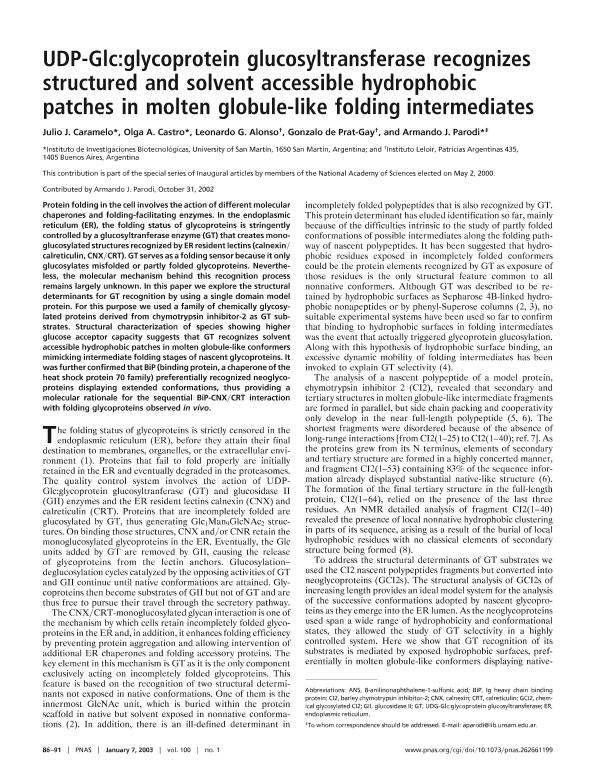Artículo
UDP-Glc:glycoprotein glucosyltransferase recognizes structured and solvent accessible hydrophobic patches in molten globule-like folding intermediates
Caramelo, Julio Javier ; Castro, Olga Alejandra
; Castro, Olga Alejandra ; Alonso, Leonardo Gabriel
; Alonso, Leonardo Gabriel ; de Prat Gay, Gonzalo
; de Prat Gay, Gonzalo ; Parodi, Armando José A.
; Parodi, Armando José A.
 ; Castro, Olga Alejandra
; Castro, Olga Alejandra ; Alonso, Leonardo Gabriel
; Alonso, Leonardo Gabriel ; de Prat Gay, Gonzalo
; de Prat Gay, Gonzalo ; Parodi, Armando José A.
; Parodi, Armando José A.
Fecha de publicación:
12/2002
Editorial:
National Academy of Sciences
Revista:
Proceedings of the National Academy of Sciences of The United States of America
ISSN:
0027-8424
e-ISSN:
1091-6490
Idioma:
Inglés
Tipo de recurso:
Artículo publicado
Clasificación temática:
Resumen
Protein folding in the cell involves the action of different molecular chaperones and folding-facilitating enzymes. In the endoplasmic reticulum (ER), the folding status of glycoproteins is stringently controlled by a glucosyltranferase enzyme (GT) that creates monoglucosylated structures recognized by ER resident lectins (calnexincalreticulin, CNXCRT). GT serves as a folding sensor because it only glucosylates misfolded or partly folded glycoproteins. Nevertheless, the molecular mechanism behind this recognition process remains largely unknown. In this paper we explore the structural determinants for GT recognition by using a single domain model protein. For this purpose we used a family of chemically glycosylated proteins derived from chymotrypsin inhibitor-2 as GT substrates. Structural characterization of species showing higher glucose acceptor capacity suggests that GT recognizes solvent accessible hydrophobic patches in molten globule-like conformers mimicking intermediate folding stages of nascent glycoproteins. It was further confirmed that BiP (binding protein, a chaperone of the heat shock protein 70 family) preferentially recognized neoglycoproteins displaying extended conformations, thus providing a molecular rationale for the sequential BiP-CNXCRT interaction with folding glycoproteins observed in vivo.
Palabras clave:
Glycoproteins
,
Protein Folding
Archivos asociados
Licencia
Identificadores
Colecciones
Articulos(IIBBA)
Articulos de INST.DE INVEST.BIOQUIMICAS DE BS.AS(I)
Articulos de INST.DE INVEST.BIOQUIMICAS DE BS.AS(I)
Citación
Caramelo, Julio Javier; Castro, Olga Alejandra; Alonso, Leonardo Gabriel; de Prat Gay, Gonzalo; Parodi, Armando José A.; UDP-Glc:glycoprotein glucosyltransferase recognizes structured and solvent accessible hydrophobic patches in molten globule-like folding intermediates; National Academy of Sciences; Proceedings of the National Academy of Sciences of The United States of America; 100; 1; 12-2002; 86-91
Compartir
Altmétricas



